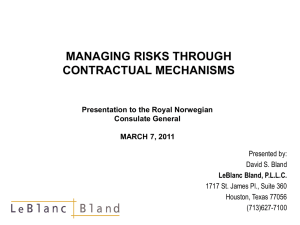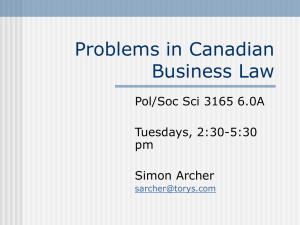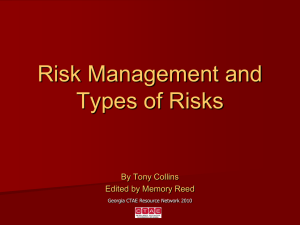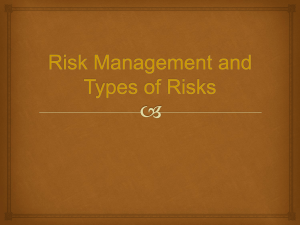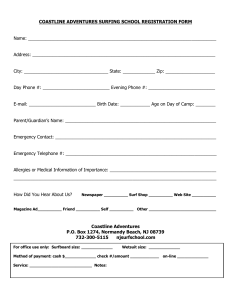Claims Issues Facing Today`s Engineering Firms
advertisement
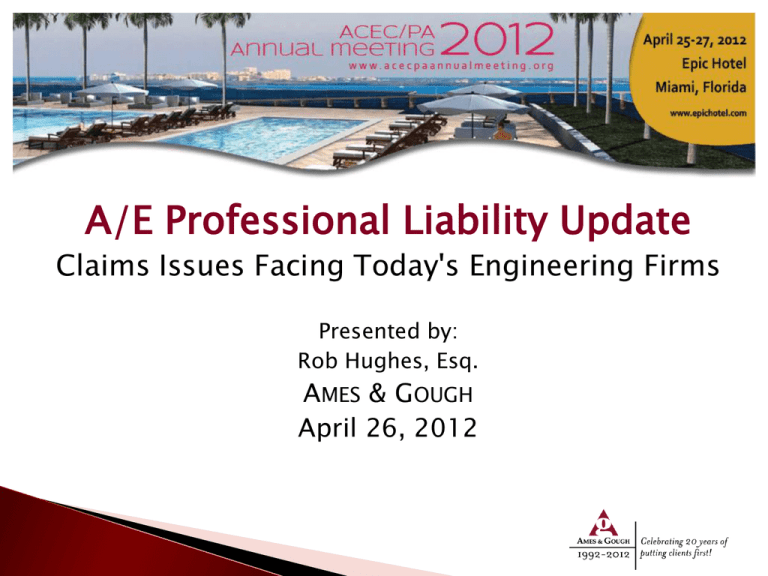
A/E Professional Liability Update Claims Issues Facing Today's Engineering Firms Presented by: Rob Hughes, Esq. AMES & GOUGH April 26, 2012 Professional Liability Claim Trends ◦ Frequency & Severity ◦ ‘Hot Topic” - Indemnity Case Studies ◦ Transportation ◦ Infrastructure ◦ Marcellus Update Insurance ◦ Technology Related Services ◦ Data Security & Confidential Personal Information SOURCE: Victor O. Schinnerer & Company, Inc. SOURCE: Victor O. Schinnerer & Company, Inc. SOURCE: Victor O. Schinnerer & Company, Inc. Professional liability - the indemnity should be based solely on events, damages or costs caused by your negligence Accept responsibility only for your acts and those of your subconsultants (vicarious liability) NOT the acts of the client (or others). Remove obligations to “defend” and replace with language that you agree to reimburse the client’s reasonable attorney’s fees Residential condominium complex. Contract included indemnity provision that required CH2M Hill to indemnify UDC for any claims, demands, injuries, etc., ". . . to the extent they arise out of or are in any way connected with any negligent act or omission" by CH2M Hill. The agreement also required CH2M Hill to defend UDC for ". . . any claim or demand covered herein.“ UDC-Universal Development v. CH2M Hill (CA Ct of Appeals, 2010) California Legislature enacted Senate Bill 972: Indemnity agreements between public agencies and design professionals are unenforceable, except for claims that arise out of, pertain to, or relate to the negligence, recklessness, or willful misconduct of the design professional. The law applies to contracts entered into on or after 1/1/11. Possible language: “The Engineer further agrees to indemnify and hold Owner free and harmless from any claim, demand, loss, damage, or injury (including attorney’s fees) caused by any negligent act or omission by the Engineer, its agents, servants, or employees.” Owner hired geotechnical engineer, civil engineer and a general contractor. Geotech had 2 contracts – investigation phase and construction phase. Owner claimed damages of $5.35M for repair of bldg and parking lot and $6.5M in diminished value of the bldg. Verdict of $486,000 on the bldg - 10% geotech and 90% GC. Parking lot 50/50 Owner and GC on $1.6M in damages. Trial Court – Owner entitled to recover all of its legal fees ($810,000) based on the plain language of the indemnity agreement in the second of the two Owner/Geotech contracts. Fifth Circuit – overturned the trial court, but only to extent that the Owner had to allocate fees between successful and unsuccessful claims – “Wal-Mart’s recovery should have been limited to those attorney’s fees incurred in proving Qore’s liability on the building repair claim.” In the end the expansion cost $4,793,544.52, or $585,544.52 an overrun of nearly 14 percent. Included in that $585,544.52 figure was a payment which the Town Council authorized the Utility to make to the GC, to resolve the latter’s claim for $1,202,404.92, “primarily for costs and damages allegedly arising out of design errors, omissions of, and constructive changes caused by the original project engineer.” Utility and the town asserted claims, relating to the design of the expansion, for breach of contract, negligence, and breach of warranty of the adequacy of the plans and specifications. Settlement for $275,000. Town/Utility’s counsel argued in support – ◦ The cost of legal defense was coming off the face value of the policy. The $275,000 figure represents an amount “over and above” the policy’s limits. City of Salisbury filed a $28 million lawsuit against an engineering company that city leaders blame for problems with the wastewater treatment plant. Salisbury Mayor Jim Ireton said, "I don't believe we're responsible for why it's not 100 percent.“ The city spent $84 million on upgrades at the wastewater treatment plant. The city claims that the design cannot handle the city's current load or the environment. Also alleges O'Brien & Gere was not up front with how much and how difficult it would be to operate the newly upgraded plant. The city is seeking damages for repair of the wastewater treatment plant's ◦ design defects, ◦ increased cost of operation, & ◦ recovery of any monetary penalties imposed by the state of Maryland and/or the U.S. Environmental Protection Agency for non-compliance with the city's wastewater discharge permit and/or sanitary sewer overflows. Extreme risk – New Construction & >250 ft in length Case Study - Indian River (DE) Inlet – After spending upwards of $21M in constructing bridge approaches, DElDOT announced they would have to be removed due to excessive settlement. DelDOT filed suit against bridge design firm Figg Bridge Engineers, Inc. and its geotechnical subconsultant MACTEC Engineering and Consulting, Inc. for geotechnical errors Failed to account for the nature and extent of settlement of soil under the earthen roadway embankments The suit further alleges that MACTEC provided erroneous information regarding the soil settlement to DelDOT. DelDOT seeks as damages its costs to construct the original earthen embankments and their partial removal, together with other related damages in excess of $19.6 million. DelDOT and others peer reviewed the design. 2005 original bridge design was cancelled, with any subsequent design requiring substantial changes to the embankments. By spring 2008 data showed settlement had stopped and as built embankments could have been used. As of January 2008 DelDOT had incurred $2.1M in legal and expert fees. Highway work zones across the country that have killed at least 4,700 people and injured 200,000 in the last five years alone. “Behind this human toll is a litany of mundane hazards: concrete barriers in the wrong position, obsolete lane markings left in place, warning signs never deployed.” Ohio created a system to monitor work-zone crashes in real time, they were startled to discover that the presence of construction caused accident rates to jump as much as 70 percent Accidents involving dangerous drop-offs kill about 160 people and injure 11,000 each year. Assume motorists will reduce their speed only if they perceive a need to do so…[R]educed‐speed zoning should be avoided as much as possible. Traffic safety in construction and maintenance zones should be an integral and high‐priority element of every project from planning through design and construction. 1) Ensuring that all phases of the project are being built as per plan, specifications, and contract 2) Monitoring the traffic control plan to ensure safe travel for the public through the work zone; 3) Ensuring compliance with environmental commitments, permit requirements, and “Best Practices”; 4) Monitoring project activities for compliance with all OSHA and state safety requirements to ensure a safe working environment; 5) Quality assurance through materials testing; 6) Rejecting materials and work that does not comply with the plans and specifications; 7) Preparing and managing all documentation related to the project; 8) Approve payments for work completed satisfactorily; 9) Monitoring compliance with all federal and state labor requirements. Study reviewed updated DOT Manuals (since 2005) - The results indicate that there is no standard definition of “errors and omissions” used by these12 state DOTs, but a number of definitions share common ideas. Optional threshold values that serve as a guide in determining whether or not to pursue cost recovery. Examples – ◦ 5% of the construction contractor’s bid or $20,000, whichever is less. ◦ Change Order >$200,000 or totaling >10% of construction value ◦ $20,000 for a single occurrence, and $50,000 for cumulative occurrences. Compared with – When consultant errors, omissions, or contractual breaches rise to the level of negligence, the Department shall pursue recovery for certain added project costs. The consultant should only be held accountable for the costs of the new design – not for additional construction costs resulting from such errors – unless are result of gross negligence or carelessness.” While it is true that our streets and highways need not be brought into compliance with design standards immediately upon the adoption of those standards, new requirements for roadway safety are to be implemented when a significant project such as a roadway re-design or even resurfacing is undertaken. At that point, it is incumbent upon the project engineer to look around to assess and correct all substandard conditions. Plaintiff and his wife were driving southbound on the I-15 on their way home from a trip to the Grand Canyon. Plaintiff's wife was driving on a downgrade stretch of highway known as the "Baker Grade" when she was forced to steer left to avoid another car. Plaintiff lost control and the car rolled over. Plaintiff claimed that the road was in a dangerous condition - the shoulder width was insufficiently narrow and an excessive drop off at the edge of pavement led to the loss of control. The median shoulder sloped downward more severely than was called for in the design plans. $10.6 Million - Defective Roadway FAIRMONT, W.Va. -- The brief testimony of a West Virginia sheriff Wednesday was enough to put the Marcellus Shale industry on the defensive as Sen. Jay Rockefeller, D-W.Va., probed companies on who is driving the heavy trucks that dominate his state's roadways. All local ordinances are preempted, except those adopted pursuant to the Municipalities Planning Code (“MPC”) and the Flood Plain Management Act. Ordinances cannot address the same features or purposes as Act 13, and are also preempted by state and Federal environmental statutes. local ordinances also must provide for the “reasonable development of oil and gas”: Allow pipeline/well assessment (including seismic testing) throughout the local government. No conditions on construction more stringent than other industrial uses. No conditions more stringent than those imposed on industrial uses or other land development in the zoning district, including those for height, screening, fencing, lighting and noise. The new legislation requires drillers to provide the state with a list of chemicals used during hydraulic fracturing, with the exception of chemicals the energy companies deem “trade secrets.” Disruption of any web interface, Accidental transmission of computer viruses, Unintended release of, or damage to, confidential client files and information, including designs and blueprints of public and commercial buildings or other structures that might be potential targets for theft and related criminal activity or terrorism. Professional or Technology Liability insurance for network security, cyber attack and web content liability, included against a party’s unauthorized access, use, tampering into data or computer system or failure to properly handle, manage or store personal confidential information in any form. The insurance shall cover the infringement of a 3rd party’s intellectual property. The insurance shall also provide coverage to mitigate claims such as re-issuing of credit cards, cost of credit monitoring and cost of notification. Limits of at least $5,000,000 per claim. Professional services includes ordinary technology services provided for others on the course of professional services described above. Such technology services include the design, development programming, analysis, training, use, hosting, management, support and maintenance of any software, database, internet service, or website; Questions? Rob Hughes, Esq. Senior Vice-President Ames & Gough rhughes@amesgough.com

